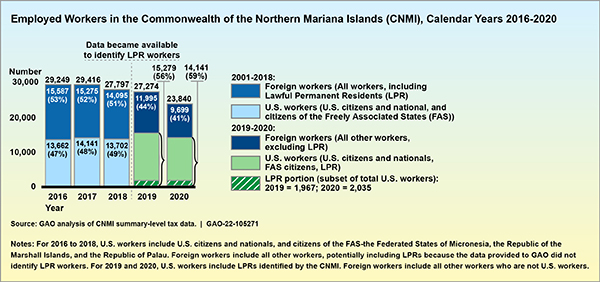GAO: CNMI foreign workers down 73% in last 20 years
The number of foreign workers in the CNMI fell by 73% from 2001 to 2020, according to the results of a study released yesterday by the U.S. Government Accountability Office on trends in the Commonwealth’s workforce and wage distribution.
The results of the GAO study show that the size of the CNMI workforce grew from 2014 to 2017 before contracting by about 5.6% in 2018, based on the CNMI tax data. By 2020, the CNMI workforce had dropped by 19% workers from the 2016 level.
Latesha Love, director of GAO International Affairs and Trade, prepared the study.
GAO found that the overall number and share of foreign workers in the CNMI workforce fell significantly over the last 20 years, from about 36,000 workers in 2001, to about 9,700 workers in 2020, representing about a 73% decline.
The number of U.S. workers remained more stable than the number of foreign workers, dropping from about 15,500 workers in 2001, to about 14,000 workers in 2020, about a 9% decline.
Overall, the share of U.S. workers increased over those 20 years, representing 30% of the workforce in 2001 and 59% in 2020.
GAO said this trend could continue as CNMI tax data is expected to increasingly enable the identification of persons lawfully admitted for permanent residence, or LPRs—shifting workers previously counted as foreign workers to U.S. workers—thereby increasing the percentage of U.S. workers.
GAO said U.S. workers were about half of the workforce in 2016 but 59% in 2020, in part due to a 2019 law that allowed foreign workers with employment visas to become long-term U.S. residents.
The NMI U.S. Workforce Act of 2018 included a provision for GAO to biennially examine the ratio of U.S. workers to other workers in the CNMI over the five previous calendar years. GAO was also asked to examine the structure of wages for workers in the CNMI.
The report examines recent trends in composition of the CNMI workforce, including the ratio of U.S. workers to foreign workers in the CNMI during the previous five calendar years.
The report also examines the distribution of wages for workers in the CNMI from 2019 through 2021.
GAO also found out that an annual study showed the number of workers earning less than $8 an hour declined by 68% from 2019 to 2021 due to the COVID-19 pandemic and lower study participation.
Under the CW program, which is the program for foreign workers in the CNMI, the ratio of U.S. to foreign workers in the CNMI remained close to 50% from 2016 through 2018.
U.S. workers increased to 56% in 2019 and 59% in 2020, partly because the CNMI government identified LPRs in the total of U.S. workers.
The size of the overall workforce grew from 2016 to 2017 before contracting by about 2,000 workers in 2018, and dropped by more than 5,000 workers from 2016 to 2020.
According to the 2020 Census, the total population of the CNMI in 2020 was 47,329.
The U.S. Department of Homeland Security approved about 11,600 CNMI-Only Transitional Worker (CW-1) foreign worker permits in 2019 and about 5,400 in 2021, dropping from a high of 13,685 in fiscal year 2017.
The overall number of CW-1 permits approved by USCIS fell from a high of 13,685 in fiscal year 2017 to 5,365 in fiscal year 2021.
The number of approved CW-1 permits in fiscal year 2021 was over 6,000 below the updated 2021 cap established in 2018.
The number of CW-1 permits in fiscal years 2012 to 2015 remained well below the annual numerical limits and exceeded or neared those limits in fiscal years 2016 through 2018, while dropping again in fiscal years 2019 to 2021.
The Disaster Recovery Workforce Act temporarily increased the CW-1 program caps for construction and extraction occupations by 3,000 in fiscal years 2020, 2021, and 2022 for certain eligible individuals.
Under the NMI U.S. Workforce Act of 2018, a transition period, during which CW workers may be admitted to perform work, is set to end on Dec. 31, 2029.
GAO noted that for 2016 to 2018, U.S. workers include U.S. citizens and nationals, and citizens of the Federated States of Micronesia, the Republic of the Marshall Islands, and the Republic of Palau. Foreign workers include all other workers, potentially including LPRs because the data provided to GAO did not identify LPR workers in that period.
In 2019 and 2020, U.S. workers now include LPRs identified by the CNMI. Foreign workers include all other workers who are not U.S. workers.
GAO said that, according to the Prevailing Wage Study, an annual study of employers in the CNMI, the reported number of employees earning less than $8 per hour declined by 68% from 2019 to 2021. The decline is largely due to economic hardship during the COVID-19 pandemic and to lower study participation by private businesses.
Because of the decline in the number of low-wage workers, 94% of CNMI workers in the PWS currently earn above the federal minimum wage of 7.25 per hour, an increase from 73% in 2019.
The COVID-19 pandemic led to large declines in the number of employees in the CNMI.
According to the data from the CNMI Department of Finance, the number of workers in the CNMI dropped by 13% from 2019 to 2020. This decline in workers is largely due to economic hardship during the pandemic, primarily in the tourism industry.
GAO, often called the “congressional watchdog,” is an independent, nonpartisan agency that works for the U.S. Congress.
























